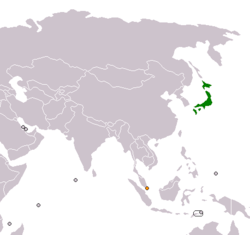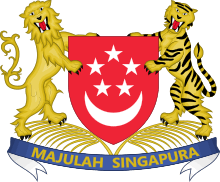Japan–Singapore relations
 | |
Japan |
Singapore |
|---|---|
| Diplomatic Mission | |
| Japanese Embassy, Singapore | Singaporean Embassy, Tokyo |
| Envoy | |
| Ambassador Kenji Shinoda | Ambassador Lui Tuck Yew |
Japan–Singapore relations refer to the bilateral relations between Japan and the Republic of Singapore. While the two countries first established bilateral relations in 1966,[1] some of the earliest interactions date back to Japan's invasion of Singapore during World War II. The invasion led to a takeover of the country, after which Japan occupied Singapore for approximately three years before withdrawing following their loss in the war.
Despite the antagonistic beginning of their relationship, the two countries now benefit from heavy mutual trade, formally established through the 2002 Japan-Singapore Economic Partnership Agreement.[2]
Country comparison
| Country Name | ||
|---|---|---|
| Coat of Arms |  |
 |
| Flag |  |
 |
| Population | 126,672,000 | 5,607,300 |
| Area | 377,972 km² (145,936 sq mi) | 719.9 km² (278.0 sq mi) |
| Capital | Tokyo | Singapore (City-state) |
| Government | Unitary parliamentary constitutional monarchy | Unitary dominant-party parliamentary constitutional republic |
| Predecessor States | British Colonial Period (1819–1946) Japanese Occupation Period (1942–1945) Interim Military Period (1945–1946) Self–Government Period (1946–1965) Independent Period (1965–present) | |
| Head of State | Akihito | Halimah Yacob |
| Head of Government | Shinzō Abe | Lee Hsien Loong |
| Legislature | National Diet | Parliament of Singapore |
| Official Languages | None | English, Mandarin, Malay, Tamil |
| GDP (nominal) | $4.841 trillion | $316.872 billion |
Timeline
Battle of Singapore
Japan's earliest notable interaction with Singapore occurred while Singapore was still colonized by the United Kingdom as a part of British Malaya. Coinciding with the December 8th surprise attack on the US naval base Pearl Harbor and the same-day attack of the British colony of Hong Kong, the Japanese empire also launched an attack on British Malaya.[3] Japan, having taken control of French Indochina in 1940, was able to launch multiple attacks and, partly due to an alliance with Thailand, took control of large swathes of Malaya over the next two months, concurrently bombing Singapore with increasing frequency. On the 31st of January 1941, Malaya fell to the Japanese, and the last of the retreating Allied forces destroyed the bridge between Malaya and Singapore and began to prepare for a full attack on Singapore.[4]
While destroying the bridge created a slight delay, the Japanese reached Singapore on the 8th of February, launching into the Battle of Sarimbun Beach. After a successful victory, Japan then launched into their second stage of the attack, during which they sustained heavy casualties but were ultimately victorious due to a miscommunication between Allied officers.[5] From here the Japanese continued to press east, ultimately taking the strategically important Bukit Timah and then moving south to take Pasir Panjang. By the 15th of February, food and water rations were low, weapon ammunition was almost exhausted, and a final meeting was held in which Allied officers agreed that no counterattack would be possible.[4] At 17:15, Lieutenant-General Arthur Percival surrendered to the Japanese forces, bringing an end to the seven day battle. The defeat was described by Winston Churchill as the "worst disaster"[6] in British military history, and is ultimately the largest surrender in British military history.[7]
Japanese-occupied Singapore
Singapore became known as Syonan-to (昭南島 Shōnan-tō), which translates into English as "Light of the South". Throughout the three and a half years of occupation by the Empire of Japan, Singapore, as well as many of the empire's other colonies, were subjected to multiple war crimes.[8] Shortly after arriving in Singapore, the Japanese Kempeitai secret police force began a purge of ethnically-Chinese Singaporeans that were deemed to be threatening to the Japanese Empire. Throughout this two week purge, referred to as Sook Ching, Singaporean men aged between 18 and 50 were subjected to a brief screening process and, if deemed anti-Japanese, were arrested and transported to one of several remote execution sites to be killed.[9] The Japanese attempted to organize a similar purge throughout Malaya, but discarded the screening process and instead engaged in indiscriminate large-scale killings of the ethnically-Chinese residents of Malaya.[10] While Japanese records indicate that the purge resulted in less than 5,000 deaths, Singapore's founder and first prime minister Lee Kuan Yew had estimated a death toll of between 50,000 and 100,000 Singaporean-Chinese men.
While many British and Australian POWs were held in Changi Prison, a number of them were also forced into slavery by the Empire of Japan, sent to work on a number of infrastructure projects throughout Southeast Asia.[11] The Japanese empire also established several comfort women houses in Singapore.[12] The education system emulated those found in other Japanese colonies, in which all students were forced to learn Japanese and discouraged from using their native language.
A new currency was introduced, popularly referred to as banana money. This currency was quickly subjected to major inflation, as Japanese officials would print more whenever they needed it and it was also easily counterfeited.[13] All Singaporeans were subject to food rations, and ration cards were distributed for citizens to redeem on a monthly basis.[14] As food availability decreased, Singaporeans were encouraged to grow their own food in their gardens.
While there were a number of guerrilla attacks on the Japanese, and the United States periodically bombed Japanese bases, occupation did not end until Japan's military surrender at the end of World War II. The interim period between Japanese occupation and re-establishment of British occupation was marked by major criminal activity and revenge-killings against the Japanese.
Establishment of relations and economic relationship
Japan and Singapore had little interaction for decades following the occupation. In 1959, a request for reparations was submitted to the Japanese government, but Japan refused them on the grounds that Singapore was still a crown colony of Britain, and they had already paid reparations to Britain in 1951. Singapore existed as a crown colony of the United Kingdom until 1963, during which they merged to become a state of Malaysia. However, following major political disagreements and racial disputes, the Malaysian government unanimously voted to expel Singapore from the union, resulting in Singapore's complete independence on August 9, 1965.
Following the establishment of independence, Japan and Singapore reached an agreement for fifty million Singaporean Dollars, though Japan did not offer an official apology for war crimes committed during the occupation.[15] However, Japan did see the potential for Singapore and became their largest trading partner, as well as their largest overseas investor.[16]
Japan's private sector was instrumental in the economic development of Singapore during its early years, with the Japanese corporations Seiko establishing a major manufacturing hub, and Sumitomo Chemical Corporation establishing Singapore's first-ever petrochemical plant. The Japan Productivity Center also advised Singapore on how to improve their own productivity.[17]
A major milestone in relations occurred in 2002 with the signing of the Japan-Singapore Economic Partnership Agreement. This document served as Japan's first economic partnership agreement with another country.[2]
Cultural relationship
Japan and Singapore have benefited from a positive relationship over the past few decades. Many aspects of Japan's culture, including their food and media, became popular in the 1990s throughout Singapore.[16]
A 2014 study found that approximately 44 percent of Singapore regards the country's relationship with Japan as "very friendly", while 53 percent of Singaporeans believe that Japan can be trusted, though "with some reservations."[16]
Japan and Singapore celebrated 50 years of relations in 2016 dubbed SJ50 with a host of Japanese cultural events held year long in Singapore.[18]
Albirex Niigata Singapore FC is a football club which plays in Singapore's Singapore Premier League. The club is a satellite team of Albirex Niigata of Japan, and its players come from Japan with some Singapore players.
One of the many annual conventions featuring Japanese pop culture is Anime Festival Asia.
References
- ↑ "Japan-Singapore Relations (Basic Data)". Ministry of Foreign Affairs of Japan (in Japanese). Retrieved 2018-03-20.
- 1 2 "MOFA: The Japan-Singapore Economic Partnership Agreement (JSEPA)". www.mofa.go.jp. Retrieved 2018-03-20.
- ↑ Gill, G. Hermon (1957). Australia in the War of 1939–1945. Series 2 - Navy. Canberra: Australian War Memorial.
- 1 2 Thompson, Peter (2005). The Battle for Singapore: The True Story of the Greatest Catastrophe of World War II. London: Portrait Books. pp. 250–251. ISBN 0-7499-5099-4.
- ↑ Elphick, Peter (1995). Singapore: The Pregnable Fortress — A Study in Deception, Discord and Desertion. London: Coronet Books. ISBN 0-340-64990-9.
- ↑ Churchill, Winston (1959). The Second World War. London: Pimlico. ISBN 9780712667029.
- ↑ Corrigan, Gordon (2010). The Second World War: A Military History. New York: Atlantic Books. ISBN 9780857891358.
- ↑ "Japanese War Crimes". National Archives. 2016-08-15. Retrieved 2018-03-19.
- ↑ "The Sook Ching – BiblioAsia". www.nlb.gov.sg. Retrieved 2018-03-19.
- ↑ "Southeast Asian Culture and Heritage in a Globalising World: Diverging Identities in a Dynamic Region (Hardback) - Routledge". Routledge.com. Retrieved 2018-03-19.
- ↑ La Forte, Robert S (1994). With Only the Will to Live: Accounts of Americans in Japanese Prison Camps 1941–1945. Wilmington, Delaware.
- ↑ "'Comfort women' were housed in Cairnhill during Japanese Occupation". Mothership.sg. Retrieved 2018-03-19.
- ↑ Boon, K.N. (2006). Malaysia Banknotes & Coins (1786-2006): A Complete Educational Reference. ISBN 983-43313-0-4.
- ↑ "PEACE LIVING CERTIFICATE ISSUED DURING JAPANESE OCCUPATION". www.nas.gov.sg. Retrieved 2018-03-20.
- ↑ "Singapore Log » Japan Made To Pay $50 million In War Reparations : Pagenation". sg.pagenation.com. Retrieved 2018-03-20.
- 1 2 3 Michishita, Narushige (2015-02-11). "Japan, Singapore, and 70 years of post-war ties". The Straits Times. Retrieved 2018-03-20.
- ↑ Koh, Tommy (2016-04-26). "Japan, Singapore and 50 years of post-war friendship". The Straits Times. Retrieved 2018-03-20.
- ↑ http://www.sg.emb-japan.go.jp/events_SJ50PA_Schedule.htm